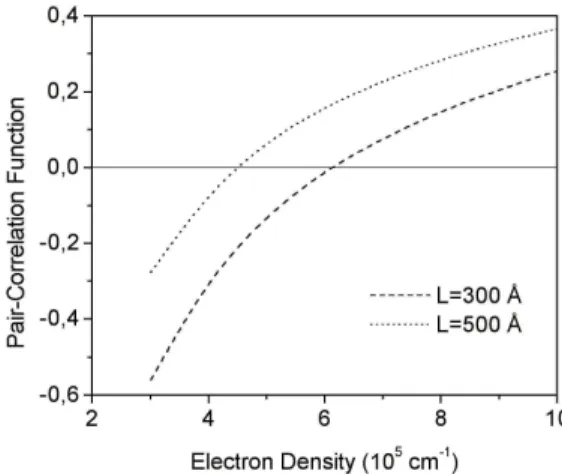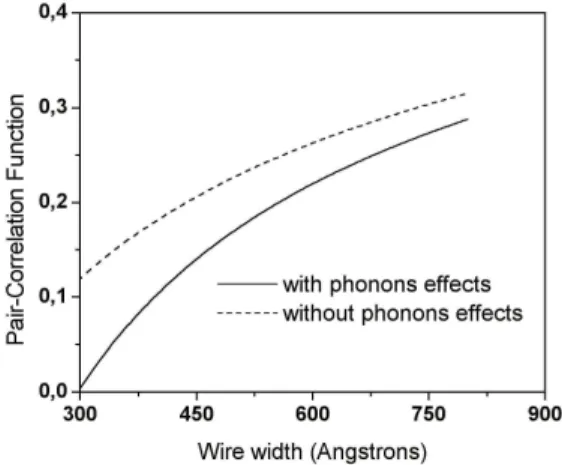Brazilian Journal of Physics, vol. 36, no. 2A, June, 2006 391
The Effects of the Plasmon-LO Phonon Interaction on the Critical Densities of
RPA Approach in a Quasi-One-Dimensional System
P. C. M. Machado∗, F. A. P. Os´orio†,‡, and A. N. Borges†,‡
∗Escola de Engenharia El´etrica e de Computac¸˜ao, Universidade Federal de Goi´as, CP 131, 74001-970 Goiˆania-GO, Brazil
†Instituto de F´ısica, Universidade Federal de Goi´as, CP 131,74001-970 Goiˆania-GO, Brazil ‡N´ucleo de Pesquisa em F´ısica, Universidade Cat´olica de Goi´as, 74605-220 Goiˆania-GO, Brazil
Received on 4 April, 2005
In this work we have studied the electron LO phonon interaction on the pair-correlation functiong(x)and its dependence on the electronic density for a GaAs-AlGaAs rectangular quantum wire within the random-phase approximation (RPA). We assumed two different values of the wire width. As negative non-physical results are found for lower electronic densities and small interparticle separations in the RPA approach, we have delimited the regions where the RPA approach cannot be used for the calculation of the Q1D electron gas collective excitation.
Keywords: Plasmon-LO phonon interaction; RPA Approach; GaAs-AlGaAs rectangular quantum wire
I. INTRODUCTION
The interest in the investigation of electron gas coupled to longitudinal-optical (LO) phonon in low dimensional semi-conductor structures has been growing motivated by the im-provements in the growth techniques and by the potential technological applications of these heterostructures [1-6]. As GaAs and AlGaAs are the main materials used to fabricate these heterostructures and they are weakly polar, the polar-ization field of the LO phonons in such materials follows the electron motion, producing a system called polaron, resulting in a polaron gas. The strength of the polaronic interaction may be strong when the frequencies of both plasmon and phonon are comparable
The many-body effects of a quasi-one-dimensional (Q1D) electron gas present in a quantum well wire (QWW) struc-ture have motivated a significant number of works [7-12]. The most common method used in theoretical works has been the random-phase approximation (RPA). For a GaAs quan-tum well wire of rectangular cross section Wendler, Haupt and Pechstedt [5] using a three subband model within the RPA, studied the coupling properties of the Q1D polaron gas and a strong interaction between different types of plasmon and the LO phonon was found. Borges, Os´orio, Machado and Hip´olito [6] studied the behavior of the inter and intra- sub-band energy dispersion relation of the polaron gas, obtained within the self consistent Singwi,Tosi,Land and Sjolander the-ory (STLS) [13]. The STLS results are compared with the RPA results and found that the differences between the two calculation methods (STLS and RPA) are more expressive for the intrasubband plasmon (0-0) and that the short range corre-lation effects are more expressive when the layer thickness of the wire decreases.
As is well known, the RPA approach leads to negative non-physical result values for the pair-correlation function g(x)
for lower electronic densities and small interparticle separa-tion However, these previous works did not study the validity of the theoretical calculation methods (RPA and STLS) as a function of the polaron gas density.
We define the critical density as the density from which
the RPA approach gives non-negative values for the pair-correlation function for small interparticle separation [14]. For density values lower than the critical density value, the local-field correction (LFC) must always be used.
In this work we study the effects of the electron - LO phonon interaction on the pair-correlation-function as a func-tion of the interparticle separafunc-tion for several values of the polaron gas densities. Also we study the critical densities as a function of the electron density for two QWW width with infinite potential barrier heights.
II. THEORY
Let us consider a rectangular Q1D quantum well wire of GaAs with widthLalong thex-direction, zero thickness layer along the z-direction at z = 0 and infinite potential barrier height in they-direction. Following the treatment of Borges et al. [6], the screening interaction potentialVi jlm(qx,ω), de-scribing the electron interaction with other electrons and with the bulk LO phonon, within the RPA approach can be written as
Vi jlm(qx,ω) =2e
2
ε∞ ∞ Z
0
dkFi jlmp(k,qx)A(ω) k2+q2
x
(1)
A(ω) =
·
1+ 2ωLO
~(ω2−ω2
LO)
ε∞α(~ωLO)2rp e2
¸
(2)
where Fi jlm(k,qx) is the form factor, which takes into ac-count the geometric form of the quantum wire,ε∞is the high-frequency dielectric constant,ωLOis the frequency of the LO phonon system, α is the Fr¨olich electron-phonon coupling constant andrpis the polaron radius.
392 P.C.M. Machado et al.
χi jlm(qx,ω) =
χlm(qx,ω)
δilδjm−Vi jlm(qx)χlm(qx,ω)
, (3)
where the symbolδi jis the Kronecker delta,χlm=Plmifl=m andχlm=Plm+Pmlwhenl=6 m.Plm(qx,ω)is the RPA polar-ization function of the Q1D electron gas. From this result, the static structure factorScan be obtained as [12]
Si jlm(qx) =−~ πρ
∞ Z
0
dωIm[χi jlm(qx,ω)], (4)
where ρ=1/L is the one-dimensional density of electrons in the system and Im[f ] denotes the imaginary part of the function f. The pair-correlation function is calculated by the relation [12]
gi jlm(x) =1+πρ1 ∞ Z
0
dqx(Si jlm(qx)−1)cos(qxx). (5)
III. RESULTS AND DISCUSSION
The pair-correlation function for GaAs-AlGaAs quantum well wires of rectangular cross section was calculated within the random-phase approximation. Two wire widths were con-sidered: 300 ˚A and 500 ˚A. The potential barrier height was assumed as infinite. The effective Rydberg energy and the ef-fective Bohr radius used in the present calculation wereR∗y= 7.67 meV anda∗0= 86 ˚A, respectively. The other parameters were assumed asε∞= 10.9,ηωLO= 36.18 meV andηωT O= 33.29 meV.
Figure 1 shows the intrasubband pair-correlation function g(x), as a function of the dimensionless interparticle sepa-ration coordinatex/a∗0 with phonon effects (solid lines) and without phonon effects (dashed lines) for three electronic den-sity values:ρ=7.7×105cm−1(higher lines),ρ=6.1×105
cm−1 (intermediate lines) and ρ=3.9×105 cm−1 (lower lines). As it can be seen, the presence of the phonon con-tributes significantly to the pair correlation function mainly in the region of small interparticle separation. The contribution of the polaronic effect in this region became g(x) more nega-tive, showing that the RPA approach is more inadequate and the Local Field Correction must be included in the calculation to give the correct results.
Figure 2 shows the intrasubband pair-correlation function near the origing(x≈0), as a function of the electronic density for two wire widths, L=300 ˚A and L=500 ˚A. The solid line at g(x)= 0 delimits the density region where the RPA approach cannot be used. In this figure it can be seen that the criti-cal density increases with decreasing wire width: the criticriti-cal density for a QWW with wire width L=500 ˚A isρ= 4.5x105 cm−1, while the critical density for a QWW with wire width L=300 ? isρ=6.1×105cm−1.
FIG. 1: The pair-correlation function calculated with (solid lines) and without phonon effects (dashed lines) for three electronic den-sity values:ρ=7.7×105cm−1(higher lines),ρ=6.1×105cm−1 (intermediate lines) andρ=3.9×105cm−1(lower lines).
Naturally the inclusion of the local field corrections, as the STLS theory, gives better theoretical results in all way, mainly as more realistic was the calculation model. The inclusion of the polaronic effects in the calculations became the system model more realistic and increases the needs of the LFC in-clusion and gives an important contribution to the excitation energy that cannot be neglected [6].
However with LFC inclusion the complexity of the calcu-lations increases very much. In this sense the results shown in Fig. 2, show the values of the electronic densities where the RPA approach gives good results. The advantage of this information is that this calculation method is very simple.
FIG. 2: The pair-correlation functiong(x≈0), as a function of the electronic density for two wire widths, L=300 ? and L=500 ?.
Brazilian Journal of Physics, vol. 36, no. 2A, June, 2006 393
expressive, and can not be neglected in the calculations.
FIG. 3: The pair-correlation function as a function of the wire width with and without the polaronic effects for electronic density ρ=6.1×105cm−1.
IV. CONCLUSION
We have calculated the intrasubband pair-correlation func-tion for a quasi-one-dimensional electron gas confined in a
GaAs-AlGaAs rectangular quantum wire with infinite poten-tial barrier height within the Random-Phase Approximation. In this calculation the effects of the electron - LO phonon interaction on the critical densities in quasi-one-dimensional systems were considered. We have studied the dependence of the pair-correlation function with the electronic density, with and without the polaronic contribution. We have found the electronic densities values where g(x) assumes positive values for small interparticle separation. We also have verified that the critical density increases with decreasing wire width and as more realistic the model of calculation as more inadequate is the RPA approach to calculate the collective excitation en-ergies
Acknowledgement
We thank to the Fundac¸˜ao de Apoio `a Pesquisa FUNAPE – UFG and Pr´o-Reitoria de Pesquisa e P´os-Graduac¸˜ao da UCG (PROPE) for financial support.
[1] K. Putteneers, F. Brosens, S. N. Klimin, and J. T.Devreese, Solid State Comm.135, 108 (2005).
[2] S. N. Klimin and J. T. Devreese, Physical Rev. B68, 245303 (2003).
[3] V. B. Campos, Marcos H. Degani, and O. Hip´olito Solid State Comm.79, 473 (1991).
[4] A. N. Borges, F. A. P. Os´orio, and P. C. M. Machado, Micro-electronics Journal34, 529 (2003).
[5] L. Wendler, R. Haupt, and R. Pechstedt, Phys. Rev. B43, 14669 (1991).
[6] A. N. Borges, F. A. P. Os´orio, P. C. M. Machado, and O. Hip´olito , Modern. Phys. Lett. B13, 819 (1999).
[7] D. W. Wang, A. J. Millis, and S. Das Sarma, Solid State Comm. 131, 637 (2004).
[8] A. R. Go˜ni, A. Pinczuck, J. S. Weiner, J. M. Calleja, B. S.
Den-nis, L. N. Pfeiffer, and K. W. West, Phys. Rev. Lett.67, 3298 (1991).
[9] A. N. Borges, M. H. Degani, and O. Hip´olito, Superlat.and Mi-crostruc.13, 51 (1993).
[10] A. Gold and A. Gazali, Phys. Rev. B41, 7626 (1990); ibid41, 8318 (1991).
[11] A. N. Borges, O. Hip´olito, and S. A. Le˜ao, Phys. Rev. B15, 4680 (1997).
[12] P. C. M. Machado, J. R. Leite, F. A. P. Os´orio, and A. N. Borges Phys. Rev. B56, 4128 (1997).
[13] K. S. Singwi, M. P. Tosi, R. H. Land, and A. Sjolander, Phys. Rev.176, 589 (1968).

